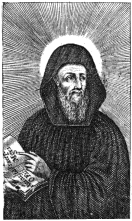
| Contents | S. Benedictus, Abbas St. Benedict, Abbot |
Home |

 From Regula S. Patris Benedicti Abbatis et Patriarchae Monachorum, Einsidlensis, 1688. From Regula S. Patris Benedicti Abbatis et Patriarchae Monachorum, Einsidlensis, 1688. |
St. Benedict was born in Nursia in central Italy sometime around 480 AD. He was sent to Rome for his studies, but finding Rome too worldly, he soon left there. Not long afterwards he retired to a cave near Subiaco to live in solitude. He became known for his sanctity and many came to him to join him in his monastic way of life. The numbers where such that he founded several monasteries for them in the area. About the year 530 he left Subiaco and founded Montecassino, where he lived until his death in 550 and is still occupied by Benedictine monks today. It was at Montecassino that he wrote his famous Regula (Rule) which has formed the basis of Western Monasticism and was a very potent force in the building up of civilization in Europe. As a result, he is called the Father of western monasticism and was proclaimed Patron of Europe by Pope Paul VI in 1964.
Pope St Gregory the Great chronicled the life of St Benedict in his work, Dialogues, Book II. Several miraculous incidents are recorded there which are worth noting and appear frequently in devotions to St Benedict. One of these occurred early in St. Benedict's monastic life. While he was living in the cave near Subiaco, the monks of Vicovara pleaded with St. Benedict to become their abbot, their previous abbot having passed away. St. Benedict was reluctant to do so since it was clear to him that the monks of Vicovara did not lead lives in accord with the monastic ideals he himself held. Desipte St Benedict's warning, they were insistent so he eventually he accepted and became the head of their group. Soon afterwards it was clear that the good saint was right in his estimation of the monks for many monks began to resist the saint's gentle guidance. One group went so far as to try and poison St. Benedict's wine. It was St Benedict's custom to always say the blessing before eating and upon making the sign of the cross over the cup, it shattered, spilling the poison wine. St Benedict, realizing what the situation was simply replied that his monastic ideals and theirs were simply not suited to one another. He then retied to his cave at Subiaco. St. Benedict's symbol is a raven with a bun on its beak. He is often portrayed holding a book with a broken chalice, or a sieve, or carrying an open copy of his rule. He has two major feast days, March 21 and then again on July 11. He died on March 21 and this is the date of his feast in the 1962 Roman Missal. Since this date often falls within Lent, the Benedictines have long celebrated his feast with great solemnity on July 11. In the current Roman Missal, his feast is celebrated on July 11 and the March 21 feast has been deleted. |
Orationes (Prayers)
- Oratio Sancti Benedicti
Prayer of St BenedictPreces et Devotiones ad S. Benedictum (Prayers and devotions to St. Benedict)
- Commemoratio Sancti Benedicti
Commemoration of St. Benedict- Septem Litaniae de Sancto Benedicto
Seven Litanies to St. Benedict (Haeften, 1644)- Tres Litaniae de Sancto Patre Nostro Benedicto, Monachorum Patriarcha
Three Litanies to Our Holy Father St Benedict, Patriarch of Monks- Litaniae de Sancto Patre Nostro Benedicto
Litany to Our Holy Father St. Benedict, (Gangelt, 1649)- Novena Litaniarum ad Sanctum Benedictum
Novena of Litanies to St BenedictHymni (Hymns)
- Gemma Caelestis
O Costly Gem
External Links:
Montecassino has a web site where you can see some of the sights: here
The St Pachomius Orthodox Library has the Dialogue of Pope St Gregory the Great containing the Life of St Benedict.
<- Prev |
Next-> |
